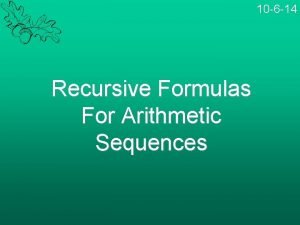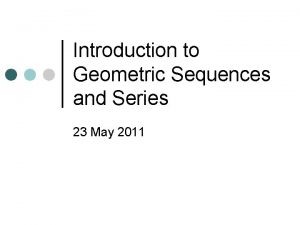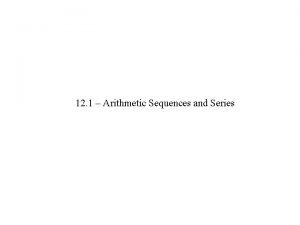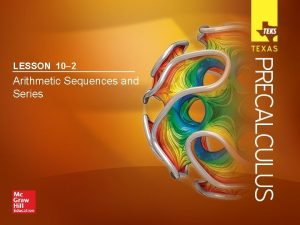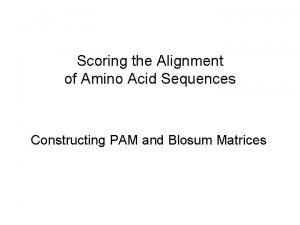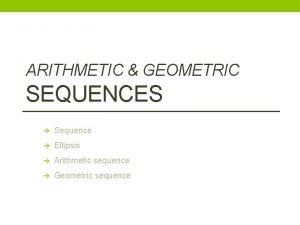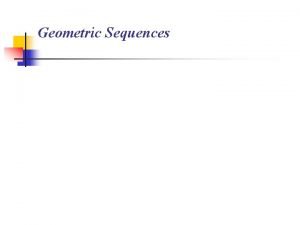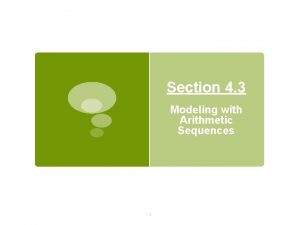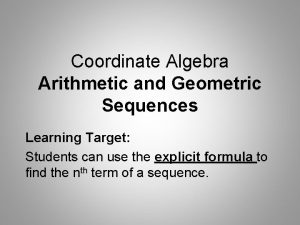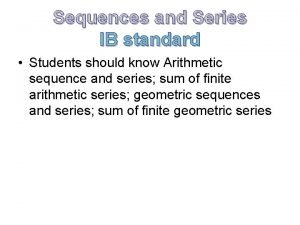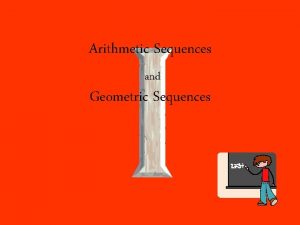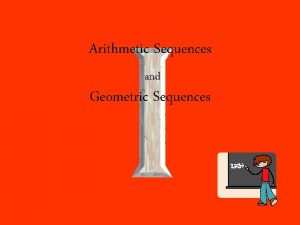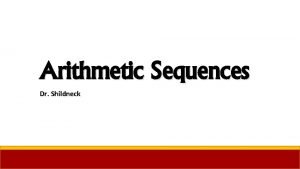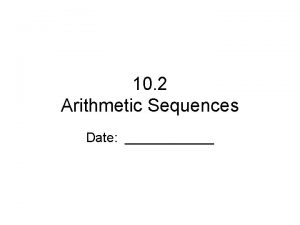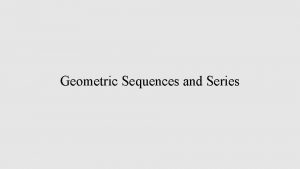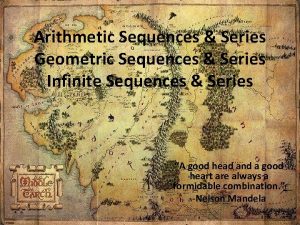Arithmetic Sequences Arithmetic Sequence An arithmetic sequence is












- Slides: 12

Arithmetic Sequences

Arithmetic Sequence An arithmetic sequence is a sequence that has a constant difference between consecutive terms.

Arithmetic Sequence An arithmetic sequence has an additive relationship (common difference) between terms. Terms add or subtract

Examples The arithmetic sequence 74, 67, 60, 53, … represents the amount of money that Tiffany owes her mother at the end of each week. Find the next three terms.

Examples The arithmetic sequence 74, 67, 60, 53, … represents the amount of money that Tiffany owes her mother at the end of each week. Find the next three terms. 74 67 60 53 The common difference is -7 The next three terms are 46, 39, 32 . . .

Examples Find the next four terms of the arithmetic sequence 9. 5, 11. 0, 12. 5, 14. 0, …

Examples Find the next four terms of the arithmetic sequence 9. 5, 11. 0, 12. 5, 14. 0, … 9. 5 11. 0 12. 5 14. 0 The common difference is 1. 5 . .

Writing Arithmetic Sequences (Recursive Rule) Each term in a recursive rule can be expressed in terms of the first term, a 1, the value of the previous term, an-1, and the common difference d. an = an-1 + d

Writing Arithmetic Sequences (Explicit Rule) Each term in an explicit rule can be expressed in terms of the term number, n, first term, a 0, and the common difference d as the rate of change. an = a 0 + d*n

Examples The arithmetic sequence 12, 23, 34, 45, … represents the total number of ounces that a box weighs after each additional book is added. Write a recursive rule and an explicit rule for the sequence. Find the 10 th term in the sequence.

Examples Recursive Rule Explicit Rule an = an-1 + d an = a 0 + d*n a 1 = 12 a 0 = 12 - 11 d = 11 a 0 = 1 an = an-1 + 11 d = 11 an = 1 + 11 n

Examples Find the 10 th term in the sequence. an = 1 + 11 n a 10 = 1 + 11(10) a 10 = 111
 Recursive formula for arithmetic sequences
Recursive formula for arithmetic sequences How to find the common difference of an arithmetic sequence
How to find the common difference of an arithmetic sequence Geometric sequence
Geometric sequence Introduction to arithmetic sequences
Introduction to arithmetic sequences 10-2 arithmetic sequences and series answer key
10-2 arithmetic sequences and series answer key Constructing arithmetic sequences
Constructing arithmetic sequences Arithmetic recursive formula
Arithmetic recursive formula Geometric sequence diagram
Geometric sequence diagram 4.3 modeling with arithmetic sequences
4.3 modeling with arithmetic sequences Explecit formula
Explecit formula Geometric sequence equation
Geometric sequence equation Writing arithmetic sequences
Writing arithmetic sequences Formula of geometric sequence
Formula of geometric sequence
